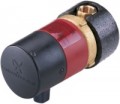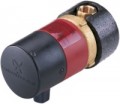Inlet
The size of the inlet provided in the design of the pump. For plumbing threads (see Connection), the size is traditionally indicated in inches and fractions of an inch (for example, 1" or 3/4"), for flanges, the nominal diameter (DN) of the bore in millimetres is used — for example, DN65.
This parameter must match the dimensions of the mount on the pipe to which the pump is planned to be connected — otherwise, you will have to use adapters, which is not very convenient, and sometimes not recommended at all.
Outlet
The size of the outlet provided in the design of the pump. The value of this parameter is completely similar to the size of the inlet (see above).
Impeller material
It is the material from which the impeller is made. It is the main part of the pump, which provides pressure due to movement.
—
Plastic. This material is inexpensive in itself, and it is easy to process, due to which it is distinguished by low cost. In addition, plastic is not subject to corrosion. On the other hand, it is considered the least reliable of all materials used in modern pumps and, therefore, is used in relatively inexpensive models that are not designed for serious loads. The exception to this rule are special high-strength polymers but they are rare.
—
Stainless steel. As the name suggests, stainless steel is virtually corrosion-resistant. However, this is not its only advantage — this material is very durable and reliable, and due to this, it is used even in powerful high-performance models.
—
Cast iron. This material is in many ways similar to steel — in particular, it is considered very reliable — but it has a slightly higher weight. On the other hand, in most cases, this is not a noticeable drawback, but cast iron costs a little cheaper than stainless steel.
—
Brass. An alloy based on copper and zinc which has a golden colour. The varieties used in circulation pumps are highly resistant to corrosion, they surpass even stainless steel. Therefore, this option is well suited for
...water with a high oxygen content. The disadvantage of brass can be called a rather high cost.Protection class
It is an indicator that determines the degree of protection of dangerous (moving and current-carrying) parts of the hardware of the pump from adverse effects, namely solid objects and water. Since pumps, by definition, are used for pumping liquids, and many of them can normally pass quite large particles, in this case, we are talking about protection against moisture and objects from outside.
The level of protection is usually indicated by a marking of the letters IP ("ingress protection") and two numbers, the first of which indicates protection against the effects of solid objects, and the second — against the ingress of water.
For the first digit, each value corresponds to the following protection values: 1 — protection against objects with a diameter of more than 50 mm (large body surfaces) 2 — against objects with a diameter of more than 12.5 mm (fingers, etc.) 3 — against objects more than 2.5 mm (most tools) 4 — against objects larger than 1 mm (virtually all tools, most wires) 5 — dust-proof (total protection against contact; the dust can enter, but does not affect the operation of the device) 6 — dust-proof (case with full dust protection and contact).
For the second digit: 1 — protection against vertically falling drops of water 2 — against drops of water with a deviation of up to 15 ° from the vertical axis of the device 3 — against drops of water with a deviation of up to 60 ° from the vertical axis of the device (rain) 4 — again...st splashes from any direction 5 — from jets from any direction 6 — from sea waves or strong water jets 7 — short-term immersion to a depth of up to 1 m (without the possibility of continuous operation in immersed mode) 8 — long-term immersion to a depth of more than 1 m (with the possibility of permanent operation) in immersed mode).
In some cases, one of the numbers may be replaced by the letter X — this means that the official certification for the corresponding parameter has not been carried out. In pumps, X is usually put in place of the first digit, because a high degree of moisture resistance in itself means a high degree of protection against solid contaminants. At the same time, for such models, an additional letter index can be provided, which describes the degree of protection against specific solid objects — for example, IPX2D. The letter D corresponds to the highest degree of stability, which does not allow the wire to be hit; the previous options A, B and C respectively mean protection from the hand, from the finger and a small tool like a screwdriver.
Port-to-port length
The installation length is the distance between the inlet and outlet of the pump, in other words, the length of the segment occupied by the pump in the circuit. This parameter allows you to estimate the amount of space required for the unit, and determine the length of the pipe section that needs to be cut.

